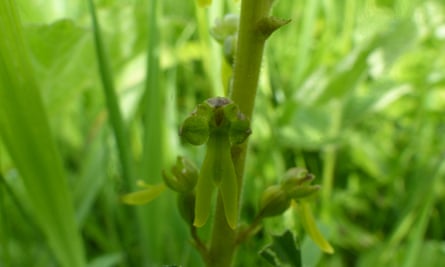The rain-soaked chalk hills are a celebration of green: the green of crimped agrimony leaves and glaucous sedge blades; of horsetail, hogweed and unripe wayfaring berries. Greenery everywhere, energising everything. I hear it in the whitethroat’s scratchy bursts, see it in sunlight on spent cowslips and feel it in the pull of my breath as I climb the hill. I wonder if it’s the heightened sensitivity of the human eye to green light that has brought on this verdant synaesthesia. Whatever the reason, the intensity of colour fuses and confuses my senses, making it hard to spot the green orchids I’ve come here to see.

But as the path narrows, the abundance of orchids – all of them common twayblades (Neottia ovata) – is such that I almost tread on one. Kneeling in the grass for a closer look, I can see inflorescences rising from pairs of egg-shaped leaves, each with a slender downy stem and green flowers held aloft on short stalks. Every year I’m astonished by the huge personalities of these miniature blooms. The labellum (the lower modified petal) is deeply forked like a pair of legs, and banded with two dark green stripes that mark a nectar-bearing groove.
With two smaller lateral petals and three rounded sepals forming arms and a hood, common twayblade flowers are often said to resemble a person, though this one looks like a Clanger, with its reddened snout and ears. It wears a zipped-up babygrow and reaches out its arms for a hug. Like the species-rich grassland itself, it is endearingly, unassumingly, spectacularly green.
Exploring the chalk hills in early summer reminds me that green isn’t just a secondary colour. At its root lies the Old English word grene, which shares its genesis with the roots of “grass” and “grow”, suggesting that the link between green pigmentation and plant growth was first recognised millennia ago. But its season in the limelight is nearly done. Soon the yellows of lady’s bedstraw, common rock rose and bird’s-foot trefoil will rise, the latter attracting great puffs of chalk hill blue butterflies, as nature’s kaleidoscope moves on.
Source: theguardian.com


